KATHERINE TINGLEY TIMELINE
1847 (July 6): Katherine Tingley was born Catherine Augusta Westcott in Newbury, Massachusetts.
1850s: As a child Tingley was greatly influenced by nature, New England Transcendentalism and the Masonic background of her grandfather Nathan Chase.
1861: Tingley attended to those wounded in the Civil War while her family was in Virginia
1862–1865: Horrified at her response to the suffering soldiers, Tingley’s father sent her to Villa Marie Convent in Montreal, Quebec, over objections from her grandfather.
1867: Tingley briefly married Richard Henry Cook, a printer.
1866–1887: There is little or no documentation for this period, but Tingley had two unsuccessful, childless marriages. During part of this time, she was in Europe working in a travelling stage/drama group.
1880: Tingley married George W. Parent, an investigator for New York Elevated. The marriage ended by 1886.
1880s: Tingley adopted and raised two children, from her former husband, Richard Henry Cook’s, second marriage.
1887: Tingley formed the Ladies Society of Mercy to visit hospitals and prisons.
1888: Tingley married Philo B. Tingley in the spring. Philo B. Tingley joined the Manhattan, New York City Masonic group that year, where William Q. Judge was the almoner.
1888–1889: Katherine Tingley met William Q. Judge during a cloakmakers strike, somewhere between fall of 1888 and winter of 1889. Judge investigated her work for the Manhattan Masonic Lodge. The Lodge provided funding for some of Tingley’s Do Good Mission efforts.
1890 (April): W. Q. Judge was ill with gradually progressing tuberculosis and Chagres fever. He sent Tingley to Sweden on secret mission to meet King Oscar II, arranged through Masonic connections.
1888–1891: Tingley established various social work outreach projects, which included the Do Good Mission and the Women’s Emergency Relief Association, which arranged and provided a soup kitchen, clothing and medical needs in New York City for the Upper Eastside and for striking immigrant garment workers.
March 1896: William Q. Judge died.
April 1896: At the second annual convention of the Theosophical Society in America an announcement was made of the prospective founding by Tingley of the School for the Revival of the Lost Mysteries of Antiquity (SLRMA), generally referred to later as the School of Antiquity. Tingley was elected as head for life of Theosophical Society in America.
1896 (June 7): A ten-month World Theosophical Crusade was inaugurated to visit Theosophical centers, form new branches, and hold Brotherhood Suppers for the poor.
1896 (June 13): World Theosophical Crusade sailed from New York City, landed in England and then went to Ireland, Continental Europe, Greece (stopping to feed hundreds of Armenian refugees), then to Egypt (October), India (November/December), Australia (January 1897), New Zealand and Samoa. While on board the ship Tingley gave Theosophical talks for the steerage underclass passengers; while at various stops in Great Britain and Europe she held Brotherhood Suppers for the poor,
1896 (September): While in Switzerland, Tingley received information that the Point Loma, California location, which appeared to her in a vision, was available. She met Gottfried de Purucker (who would become her successor) who drew a map of Point Loma. Tingley sent the cable to purchase the land at Point Loma.
1896 (October/November): Tingley described her meeting with Helena P. Blavatsky’s young Tibetan “Teacher” in Darjeeling.
1897 (January): Tingley purchased 132 acres on Point Loma in San Diego, with option to buy an additional forty acres.
1897 (February 13): Tingley arrived at Point Loma.
1897 (February 23): Tingley officially laid the cornerstone for the future School for the Revival of the Lost Mysteries of Antiquity. More than 1,000 people attended the ceremony.
1898: Tingley formally changed the name of her group from The Theosophical Society to The Universal Brotherhood and Theosophical Society.
1898 (November 19): Tingley produced a benefit performance in New York City of the Greek tragedy by Aeschylus, The Eumenides, for American soldiers and Spanish and Cuban sufferers in the Spanish American War. The New York Tribune reviewed the performance favorably.
1899 (February): Tingley met with large group from all over Cuba upon her arrival in Santiago, Cuba. She encountered Emilio Bacardi Moreau, the mayor of Santiago, Cuba and grandmaster of Masonic lodges in Cuba.
1899 (April 13): The first Universal Brotherhood Congress convened at Point Loma, with two performances of the Eumenides featuring a cast of two hundred.
1899 (September 13): The second Universal Brotherhood Congress convened in Stockholm, Sweden, with a reception attended by King Oscar II. There was another large gathering in Brighton, England, on October 6.
1899–1900: Extensive remodeling of the preexisting large sanatorium building into the Academy and Temple of Peace, along with extensive development of the Point Loma site, began.
1900: Raja Yoga school founded at Point Loma with first five students at Point Loma, including Iverson Harris Jr. and four daughters of Walter T. Hanson from Georgia: Coralee, Margaret, Estelle, and Kate.
1900: Tingley held a debate with Christians at the Fisher Opera House in San Diego. The Christians, who verbally attacked her and the Theosophists, declined to participate, and so Tingley presented both sides at the debate. She then purchased the Fisher Opera House and renamed it the Isis Theater after the Egyptian goddess.
1901: Tingley built the first Greek-style theater in America at Point Loma.
1901: Tingley produced a Greek symposium, The Wisdom of Hypatia, performed at the renamed Isis Theater. That same year saw dramatic productions of The Conquest of Death and a children’s drama Rainbow Fairy Play.
1901 (October 28): The Los Angeles Times headlined a sensationalized column: “Outrages at Point Loma: Women and Children Starved and Treated like Convicts. Thrilling Rescue.” Tingley’s subsequent suit for libel against the publisher Otis Gray, one of the most powerful people in California at that time, was successful and she was awarded $7,500.
1902: One hundred students were now enrolled at the Raja Yoga school. Two-thirds were Cuban, including children of Emilio Bacardi Moreau.
1903: Twenty-five Raja Yoga students were sent to Cuba to help launch schools there. Three schools were established. Nan Ino Herbert was the principal.
1903: Tingley journeyed to Japan with Gottfried de Purucker. She was impressed with Japanese discipline and ethic and invited Japanese educators to visit Point Loma.
1907: A Midsummer Night’s Dream was produced at Point Loma and performed in the Greek Theater, featuring original music, costumes, and set. Dozens of plays, mostly from Shakespeare and Aeschylus were produced at Point Loma over the next thirty years.
1907: Tingley had a private visit and meeting with King Oscar II of Sweden, who died a few weeks later. She purchased government land to establish a Raja Yoga school on Visingso Island in Sweden.
1909: The Raja Yoga schools were closed in Cuba due to financial strain. Tingley had been diverting Point Loma funds there, which was not sustainable.
1909: Kenneth Morris, Welsh poet and fantasist, moved to Point Loma.
1911: The first issue of The Theosophical Path appeared, with Gottfried de Purucker as acting editor. This journal was issued monthly in the same format from 1911 until 1929.
1911: Pageant and symposium, The Aroma of Athens, was written and performed by the Theosophists as a dramatic production at Isis Theater.
1911 (November): After a very moving visit to San Quentin, Tingley began to publish The New Way, an eight-page newsletter directed at prisoners and edited by Herbert Coryn. The newsletter stated that it was published by “The International Theosophical League of Humanity for Gratuitous Distribution in Prisons.”
1913 (Midsummer): 1913 (Midsummer): Tingley organized, with Swedish members, and attended with a group of Raja Yoga students from Point Loma, the Theosophical Peace Congress at Visingso Island.
1913–1920s: Tingley’s anti-war peace activities were pervasive from this time through the 1920s with many events and activities organized in San Diego and in Europe.
1914: Tingley inaugurated the Peace Day of Nations. Telegrams peace and anti-war messages were sent to President Woodrow Wilson.
1914–1915: Tingley lost part of an inheritance from A. B. Spaulding in a lawsuit brought by his heirs.
1915: Tingley suggested to plein air impressionist artist Maurice Braun, who had come to join the Theosophists in 1909, that he establish his art focus in San Diego, rather than at Point Loma. Braun became one of the founders of the San Diego Art Guild, which later became the San Diego Art Institute.
1914–1917: Tingley successfully campaigned against capital punishment in Arizona, supporting and collaborating with then-Governor George W. P. Hunt.
1917–1920: Tingley headed anti-vivisection animal rights efforts.
1919 (January): The Spanish Influenza, which raged throughout the nation, saw only a single case at Point Loma.
1920: Through a large publicity campaign Tingley successfully influenced the California governor to commute the sentence of Roy Wolff, who was seventeen at the time he killed a taxi driver.
1920s: At its height, Point Loma had residents from twenty-six nations.
1922: Katherine Tingley’s talk on Theosophy: The Path of the Mystic was printed and published at Point Loma.
1923: Adventure novelist Talbot Mundy took up residence at Point Loma, and there wrote his most mystical adventure story, Om the Secret of Ahbor Valley, in which the Lama protagonist is patterned after Tingley.
1923: Tingley met Rudolf Steiner, founder of the Anthroposophical Society, in Germany and proposed that the two groups merge. Tingley’s stroke later that year and Steiner’s death precluded this potential merger.
1923: Tingley lost a lawsuit that relatives brought in the Mohn family inheritance.
1925: Katherine Tingley’s talk on The Wine of Life, which outlined the ideal of the Theosophical home life, was printed and published at Point Loma.
1926: Katherine Tingley’s talk on The Gods Await was printed and published at Point Loma.
1927: Katherine Tingley’s talk on The Travail of the Soul was printed and published at Point Loma.
1929: Tingley had premonitions of her impending death, described by Elsie Savage Benjamin.
1929 (July 11): Katherine Tingley died in Sweden while on a European tour, following an auto accident in Germany.
BIOGRAPHY
Katherine Augusta Westcott was born in Newbury, Massachusetts on 6 July 1847. She grew up in New England, her childhood spent wandering along the banks of the Merrimac River near Newbury. The first years through her mid-teens appear to have been idyllic. She found the companionship of her grandfather, Nathan Chase, to be inspiring. She observed that she was drawn to the outdoors and described a nature-loving, interior, and more spiritualized orientation from early childhood. She portrayed her childhood experience and wonderment with the natural world, writing that “in my love of Nature and in my love of the true and the beautiful, in my love of this Eternal Supreme Power, my views broadened and I felt there is still greater knowledge and more wonderful meaning to human life” (Tingley 1925:286). Additionally, she was also drawn to the visitors and friends of her family, who were participants in the New England Transcendentalist movement. She wrote that she tried many philosophies, including Ralph Waldo Emerson, John Greenleaf Whittier, and Henry Wadsworth Longfellow, and though they stirred her, they “did not quite satisfy.”
The first major transition in her life came in 1861 during the American Civil War. Her father was a regiment captain, stationed with the Union Army in Virginia, and there she witnessed the suffering and wounded soldiers. After the second battle of Bull Run, she saw “the ambulances returning with the dead and dying, followed by the files of Confederate soldiers, ragged and half starving” (Tingley 1926:36–37). Unable to bear the sight, Tingley and her African American servant went out among the soldiers and tended their wounds late into the night. However, her father’s reaction to Katherine’s impulse to aid the suffering and wounded was not a positive one. Out of concern for Katherine’s well-being he quickly sent her off, over the protests of her grandfather, a member of the Masons, to a Catholic boarding school administered by nuns at Villa Marie Convent in Montreal, Quebec. This was a highly regimented and structured environment, a drastic change from the free-spirited life in New England. She appears to have lived there until she was eighteen, and upon completing school, for reasons not clear, she did not return to her parents’ home.
From 1865 until 1880, there is almost no information on Tingley’s life, although she was briefly married to Richard Henry Cook, a printer, in 1867. From 1880 to 1888 all that is known is that she married a second time: George W. Parent was an investigator for New York Elevated. The marriage ended by 1886. By the mid-1880s, for a short time, she adopted and raised two children who were from her first husband’s second marriage. Tingley gave little information about these marriages other than that they were times of great suffering for her.
Living in New York City brought her into contact with the horrible conditions of those living on the East Side, and in 1887 she established a women’s group to visit prisons and hospitals, called the Ladies Society of Mercy. In 1888, she married Philo B. Tingley, a steamship employee and inventor, who would be Katherine’s connection to what would become the most world-changing event in her life, namely meeting William Q. Judge (1851–1896), president of the American Section of the Theosophical Society. The same year he married Katherine, Philo Tingley had joined the Manhattan Masonic Lodge, where Judge was the bursar. Katherine’s work with the poor and particularly with the plight of striking garment workers and their working conditions was suggested as a charitable project. Judge, as the Masonic Lodge treasurer, was sent to check on it, view the project in action and determine if it was worth supporting. Historical documents discovered in 2015 clearly indicate that Judge first saw Katherine in late 1888 at her “Do Good” outreach mission, when, as she would describe later, she saw an unusual gentleman within the crowd of the downtrodden, “strikingly noble of expression, with a look of grave sadness and of sickness too” (Tingley 1926:79). They met in person for the first time in early 1889. “It was then, when I came to know him, that I realized that I had found my place. I was face to face with a new type of human nature: with something akin to that which my inner consciousness had told me a perfect human being might be” (Tingley 1926:79–80). It is remarkable that both Judge and Tingley kept her connection with him and the Theosophical Society totally secret until 1894, even though revealing it would have greatly benefited her position with those Theosophists who were critical of her.
During 1894 and possibly earlier, Katherine took Judge to warmer weather and hot springs in Texas and Arkansas for rest and 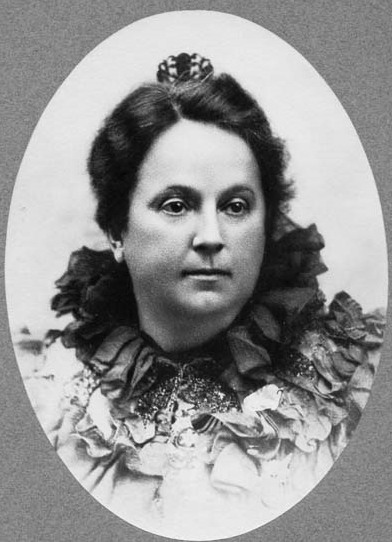 recuperation from his progressing tuberculosis and Chagres fever. At the same time, she formally joined the Theosophical Society and a month later Judge admitted her to the private Esoteric Section. As it became clearer that Judge’s chronic illness was more serious, Tingley [Image at right] was introduced to a few Theosophists in 1895. Tensions and differences had been building between William Q. Judge and both Annie Besant (1847–1933) and Henry Steel Olcott (1832–1907), who had remained with the parent Theosophical Society headquartered in Adyar, India. There were a complex and contentious series of events, which turned acrimonious at times. This finally came to a head when Judge led the American Section to secede from the Theosophical Society in 1895. Declaring autonomy, the Theosophical Society in America was established and William Q. Judge was elected president for life (Ryan 1975). At that time, Katherine Tingley rapidly moved to the center of governance as Judge’s health declined further.
recuperation from his progressing tuberculosis and Chagres fever. At the same time, she formally joined the Theosophical Society and a month later Judge admitted her to the private Esoteric Section. As it became clearer that Judge’s chronic illness was more serious, Tingley [Image at right] was introduced to a few Theosophists in 1895. Tensions and differences had been building between William Q. Judge and both Annie Besant (1847–1933) and Henry Steel Olcott (1832–1907), who had remained with the parent Theosophical Society headquartered in Adyar, India. There were a complex and contentious series of events, which turned acrimonious at times. This finally came to a head when Judge led the American Section to secede from the Theosophical Society in 1895. Declaring autonomy, the Theosophical Society in America was established and William Q. Judge was elected president for life (Ryan 1975). At that time, Katherine Tingley rapidly moved to the center of governance as Judge’s health declined further.
Upon Judge’s death in 1896, Tingley was elected president for life. Conflicts and schisms followed, but Tingley forged ahead. She quickly shifted the direction of the Theosophical Society in America to create an educational and living community where Theosophy could be practiced in daily life and not only for abstract study of metaphysics or the exploring of visionary realms. It was her aim to make Theosophy “intensely practical” and rooted in a deep altruistic ethic. At the January 13, 1898 convention, she would rename it the Universal Brotherhood and Theosophical Society (UBTS). For the direct application of her philanthropic work she also established the International Brotherhood League, which carried on a very large relief effort in Cuba in 1898 after the Spanish-American War, and also served the sick and wounded soldiers returning from the war. President William McKinley authorized the use of U.S. Government transport to take Tingley, her physicians and other workers to Cuba with large supplies of food, clothing, and medicines (Ryan 1975:348).
In 1896, she gathered together a few supporters for a Theosophical Crusade and headed off around the world, beginning in 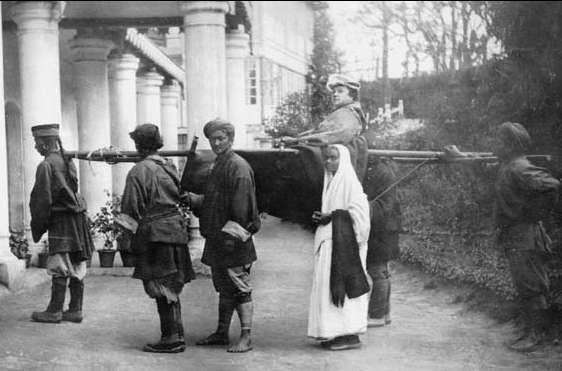 Europe. In Switzerland she met a young Theosophical Society member, Gottfried de Purucker (1874–1942) for the first time. He had joined the Theosophical Society and met Judge who admitted him to the Esoteric Section without the usual probationary period. De Purucker had been to California a few years before and lived in San Diego in 1893, working on a ranch and leading study groups in the Secret Doctrine by the co-founder of the original Theosophical Society, Helena P. Blavatsky (1831–1891). De Purucker helped Tingley identify the land at Point Loma in San Diego for purchase for the UBTS project (PLST Archive). Meanwhile, the Theosophical “crusaders” traveled through the Middle East and sailed on to India. [Image at right] Early one morning near Darjeeling, Tingley evaded her companions and slipped off up into the foothills. She would return a day or so later, stating she had visited one of Blavatsky’s “Teachers” referring to the encounter as “life transforming” (Tingley 1926:155–162; and Tingley 1928). Some years later Tingley would reflect that her encounter with Blavatsky’s young Tibetan “Teacher” in India had given her the courage to continue with establishing and developing the Point Loma community and the gradual alleviation and reversal of symptoms of her chronic Addison’s kidney/adrenal disease. For Katherine Tingley this was a much needed and spiritually life-changing experience, that brought her the energy and motivation to bring her vision of a “White City in the West” into manifestation.
Europe. In Switzerland she met a young Theosophical Society member, Gottfried de Purucker (1874–1942) for the first time. He had joined the Theosophical Society and met Judge who admitted him to the Esoteric Section without the usual probationary period. De Purucker had been to California a few years before and lived in San Diego in 1893, working on a ranch and leading study groups in the Secret Doctrine by the co-founder of the original Theosophical Society, Helena P. Blavatsky (1831–1891). De Purucker helped Tingley identify the land at Point Loma in San Diego for purchase for the UBTS project (PLST Archive). Meanwhile, the Theosophical “crusaders” traveled through the Middle East and sailed on to India. [Image at right] Early one morning near Darjeeling, Tingley evaded her companions and slipped off up into the foothills. She would return a day or so later, stating she had visited one of Blavatsky’s “Teachers” referring to the encounter as “life transforming” (Tingley 1926:155–162; and Tingley 1928). Some years later Tingley would reflect that her encounter with Blavatsky’s young Tibetan “Teacher” in India had given her the courage to continue with establishing and developing the Point Loma community and the gradual alleviation and reversal of symptoms of her chronic Addison’s kidney/adrenal disease. For Katherine Tingley this was a much needed and spiritually life-changing experience, that brought her the energy and motivation to bring her vision of a “White City in the West” into manifestation.
The Point Loma community began in 1897 with Tingley’s arrival. Great enthusiasm and energy accompanied construction and transformation of the grounds, which were called Lomaland. By 1899, the first five students were enrolled in the Raja Yoga school, and by 1902 there were a hundred, of whom about seventy-five were from Cuba. Collaborating with Emilio Bacardi Moreau (1844–1923), mayor of Santiago, Cuba, she began a mission to build schools in Cuba and to bring Cuban students to the Raja Yoga School at Point Loma. By 1915, the school in San Diego reached its peak with 500 students (Greenwalt 1978). The Raja Yoga curriculum evolved quickly, with its emphasis on the creative arts: the classics, music, drama, art, and literature, as well as science, sports and agriculture. The overarching view that the Point Loma community manifested was what Tingley called the School of Antiquity. According to Tingley’s secretary, Joseph H. Fussell, the purpose of the School of Antiquity was to revive a knowledge of the Sacred Mysteries of Antiquity by promoting the physical, mental, moral and spiritual education and welfare of the people of all countries, irrespective of creed, sex, caste or color; by instructing them in an understanding of the laws of universal nature and justice and particularly the laws governing their own being: the teaching them the wisdom of mutual helpfulness, such being the science of Raja Yoga. (qtg Tingley, Fussell 1917:12).
The School of Antiquity and the entire vision and form of the Point Loma community was patterned after Tingley’s conception of an ancient mystery school, drawing a great deal of her inspiration from Plato and Pythagorean ideas. Elsie Benjamin described the mission as being to replicate an ancient Mystery-School:
In the ancient Mystery-Schools, the pupils were more like children: they have instinct, they have intuition, but they didn’t have full self-consciousness. . . . Because Judge had told K.T., that it is not your mission to teach them technical Theosophy. Your mission is to teach them morals, ethics, universal brotherhood, humanity and self-discipline (Benjamin).
Tingley’s vision of “practical Theosophy” encompassed all of the arts, and much more. For her, the architecture of Lomaland needed to express the sacredness of home and place, as both receptacle and expression of a higher divine source. Her inspiration culturally was, at least in part, Greek and Pythagorean harmonics. Of the unique buildings designed and built at Lomaland, the Greek Theater remains as the single purely classically Greek structure. Other structures, such as the Temple of Peace or the home of Elizabeth Mayer Spaulding, wife of sporting goods magnate Albert G. Spaulding, reflected influences from India and Persia.
Drama played a significant role, not only to develop community esprit d’corps, but for the individual transformational elements involved. From 1903 into the 1930s, the Point Loma Theosophical community produced scores of plays. Tingley chose Greek tragedy and Shakespeare’s dramas for what she viewed as their philosophical perennialism and universal Theosophic ideas, combined with the participatory opportunity that drama has for inner psychological and spiritual development. There were also productions of their own plays, including one based on Socrates’ dialogues in Plato, called The Aroma of Athens. Another, based on the life of the fourth-century Alexandrian neo-Platonist woman philosopher Hypatia, featured Katherine Tingley in the lead role. Reviews in the San Diego Union reflected the central role that the Theosophical productions played in San Diego’s cultural life.
Well-known artists from the U.S. and abroad came to live and work at Lomaland and there developed a unique mystical style. The late 1890s view of art held by Reginald Willoughby Machell (1854–1927), presaged a later twentieth-century phenomenological view found in philosophers like Kitaro Nishida, Maurice Merleau-Ponty or Ananda Coomaraswamy, where an understanding of how the awareness of observer and object are experienced as highly interdependent with the art object and its creation. Said Machell:
Beauty is really a state of mind. The senses only register vibrations, which are translated by the mind into colour, form, sound. . . . It would be more true perhaps to say that beauty is in both observer and observed, but not in one apart from the other (Machell 1892:4).
Another artist who developed a Theosophical style was Maurice Braun (1877–1941). According to Emmett Greenwalt, “Braun was not hesitant in crediting Theosophy with sharpening his insight into nature. To him art was for ‘the service of the divine powers in man,’ or as he otherwise phrased it, ‘art for humanities sake,’ and he saw in Theosophy ‘the champion and inspirer or all that is noble and true and genuine in art’” (Greenwalt 1978: 129–31).
In addition to her devotion to the arts, Katherine Tingley worked for social justice and peace throughout her life. She had been involved in a prison ministry project which involved corresponding with prisoners. She was engaged in movements to abolish capital punishment in California and Arizona. She also organized an anti-vivisection program to protect animal welfare.
In 1922 or 1923, Tingley, around age seventy-six, [Image at right] suffered a minor stroke. It did not cause any noticeable physical 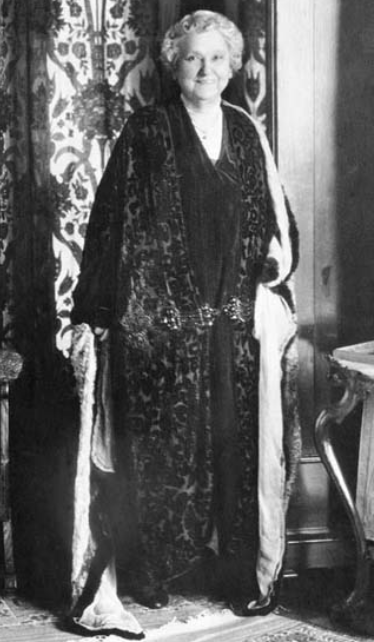 debility, but from then until her death, she suffered a kind of emotional agitation at times when under stress. When it became severe, her office staff would call for Gottfried de Purucker to come, given his very calming influence on her in general, and his presence would usually resolve Tingley’s anxieties.
debility, but from then until her death, she suffered a kind of emotional agitation at times when under stress. When it became severe, her office staff would call for Gottfried de Purucker to come, given his very calming influence on her in general, and his presence would usually resolve Tingley’s anxieties.
The last seven years of her life can be seen as a gradual decline of the Point Loma experiment, after the dynamic growth and successes of the 1910–1922 period. Her important financial backers of the earlier period had almost all died, and the expenses for maintaining Lomaland had stayed the same. Over this time, significant debt was incurred, even to mortgaging part of the property to maintain the community. The drama, art, music and Raja Yoga school continued, but the income was less. Some long-time residents also left Point Loma at this time, including Hildor and Margueite Barton, Montegue Machell and his wife Coralee (one of the Hanson sisters), and E. August Neresheimer and his wife Emily Lemke. Tingley expressed her dismay and felt that she had not lived up to supporting her committed residents and partisans, especially Reginald Machell.
By late spring of 1929, and approaching the age of eighty-two, Tingley was ready to travel to Europe yet again. Elsie Savage Benjamin, then her secretary, was helping with preparations and sharing her concerns with Tingley about the European trip. She was especially concerned about driving with an inexperienced young man whom Tingley had chosen to be her chauffeur for the tour. Tingley, with her darting, penetrating eyes rapidly responded to Elsie with extraordinary prescience: “Don’t you know, he’s going to be in a car crash and kill someone” (Benjamin n.d.). On May 31, 1929, driving in the fog near dawn on a winding road in Germany about fifty miles from the Dutch border, the chauffeur crashed the car into a concrete bridge pier (Greenwalt 1955:192). Tingley had a double fracture of her right leg and much bruising. Others in the car were also injured. Tingley insisted on being taken to Visingso Island in Sweden rather than to a hospital. Staying in command until the last, and in considerable pain, she even dismissed her doctor rather than be moved to where she could receive better medical care. Katherine Tingley died on Visingso Island, what she considered sacred land, July 11, 1929.
TEACHINGS/DOCTRINES
Tingley saw Theosophy, “not so much as a body of philosophic or other teaching, but as the highest law of conduct, which is the enacted expression of divine love or compassion” (Tingley The Theosophical Path :3). This divine love could be realized only in a communal setting in which people lived and worked together to express their best selves.
For Tingley, educating children’s minds so that they recognized the Immortal Self was “the truest and grandest thing of all as regards education” (Tingley The Theosophical Path:175). Toward this end she founded the Raja Yoga system in order to develop children’s character so that their true nature would emerge from within. “The real secret of the Raja Yoga system is rather to evolve the child’s character than to overtax the child’s mind; it is to bring out rather than to bring to the faculties of the child. The grander part is from within” (Tingley The Theosophical Path:174). The essential divinity of humanity served as the foundation for this kind of education, with a curriculum integrating body, mind, and spirit, in which all participated. Physical cultivation along with intellectual training were required, so that the intellect would be “the servant, not the master.” Thus, the Raja Yoga system, which Tingley called a “science of the soul,” would pervade all life and activity, becoming “the true expression of soul-ideals” so that art would no longer be extraneous to life, but rather an integral part of the environment (Tingley The Theosophical Path: 159–75). This view toward the arts as the means to develop the whole person helps explain Tingley’s passion for theater, since drama, in her view, reached the heart of everyone.
Clearly influenced by Blavatsky’s writings on education, Tingley nevertheless created a practical program not envisaged by her predecessor. She outlined it as follows:
The basis of this education is the essential divinity of man, and the necessity for transmuting everything in his nature which is not divine. To do this no part must be neglected, and the physical nature must share to the full in the care and attention which are required. Neither can the most assiduous training of the intellect be passed over; it must be made subservient to the forces of the heart. The intellect must be the servant, not the master, if order and equilibrium are to be attained (Emmett W. Small n.d.:93–94).
RITUALS/PRACTICES
While there was no group liturgy at Lomaland, there were daily community practices. Tingley spoke of “the sacredness of the moment and the day” and sought to make Theosophy intensely practical as “the enacted expression of divine love or compassion” (Tingley 1922:3) According to her, “The ideal must no longer be left remote from life, but made divinely human, close and intimate, as of old. NOW is the day of resurrection” (Tingley 1922:94). The daily life practice at Lomaland could be compared to the group spiritual practice in the monastic traditions of east and west, yet with unique differences. The Lomaland practice was based on the creative arts within the context of the wisdom traditions of East and West. Daily group activity was ritualized in common endeavors that were creative, contemplative and inspirational, encapsulated within an altruistic ethic. As she expressed it, “Intellectualism has no lasting power without the practice of the highest morality” (Tingley 1922:98). It was a community, the center of which was the education of children.
The entire community gathered together daily at sunrise at the Greek Theater or in the Temple of Peace. Inspirational phrases were read from literature such as the Bhagavad Gita, the Buddha’s life story in Edwin Arnold’s poetic rendition in The Light of Asia, from Theosophical sources, including Light on the Path by Mabel Collins (1885) and the Voice of the Silence by Blavatsky (1889). This was followed by silent contemplation. Meals were eaten in a group setting and in silence, with a brief recitation before each meal and upon entering the refectory eating area; men and women were grouped together. Idle talk was discouraged and the overall quality of the community was to “do well the smallest duty . . . then joy will come” (Tingley 1927:274–75).
The following invocation, given to the students by Katherine Tingley, was recited in unison primarily at meetings held in the Temple, but also on many occasions elsewhere.
Oh my Divinity! Thou dost blend with the
earth and fashion for thyself Temples of mighty power.
Oh my Divinity! thou livest in the heart-life
of all things and dost radiate a Golden Light
that shineth forever and doth illumine even the
darkest comers of the earth.
Oh my Divinity! blend thou with me that
from the corruptible I may become Incorruptible;
that from imperfection I may become Perfection;
that from darkness I may go forth in
Light.
In addition to the morning gatherings in silence and meditation with devotional readings, there was also community music, both instrumental and choral. Everyone sang in the chorus and played a musical instrument. Tingley considered music to be of central value for inner transformation and life harmony: “The soul power which is called forth by a harmony well delivered and well received does not die away with the conclusion of the piece” (Tingley 1922:178). She would attract to Point Loma the renowned director of the Amsterdam Conservatory of music, Daniël de Lange (de Lange 2003), from 1910 to 1915, who transformed the Raja Yoga orchestra into a symphonic quality musical group.
There were frequent gatherings on cultural and Theosophical subjects for presentations in the Temple of Peace. Regular Point Loma visitors, like art historian Osvald Siren (1879–1966), would give lectures in the Temple illustrated by lantern slides of photos from his recent journeys in China or Asian or European art history (Carmen Small n.d.). Lomaland was an oasis of sophistication in the cultural wasteland that was San Diego at the turn of the twentieth century.
LEADERSHIP
Katherine Tingley’s leadership began in 1896, when she was elected amidst some controversy to succeed William Q. Judge as leader for life of the Theosophical Society in America. This resulted in a number of outer changes, including the change of name to the Universal Brotherhood and Theosophical Society and also the shift of primary focus from lodges to the establishment of the community at Lomaland. These alterations also provided a shift in the internal culture within Tingley’s Theosophical movement at the time, which could be described as a shift from discursive metaphysics to Theosophy in daily activity. There was the practical work for Universal Brotherhood, e.g. promoting global peace, prison outreach, capital punishment abolition and so on, but there was also a new modality, where cultivating an inner ethic of altruistic motivation and awareness was primary. This change opened the door, to what could be described as contemplative Theosophy. As Tingley declared:
Wisdom comes not from the multiplication of spoken or written instructions; what you have is enough to last you a thousand years. Wisdom comes from the performance of duty, and in the silence, and only the silence expresses it (Tingley 1925:343).
As a self-proclaimed dictator, Tingley appeared to wield the primary power in the organization, but as the Point Loma community developed, that control was progressively counterbalanced by her delegating responsibilities to others. There was a complex of interconnected departments and committees at Lomaland, which managed everything from maintaining the extensive agricultural gardens with fruit orchards, to supervising school curriculum, Theosophical programs and running a large communal endeavor. The one area in which Tingley immersed herself was her personal direction and management of the dramatic productions in the Greek Theater at Lomaland and at the Isis Theater in San Diego. She felt most at home in the role of guide to the students’ inner development of character and spirituality when she was absorbed in the dramatic productions. In this context, she would exclaim to one student, “I work best in utter chaos” (Harris n.d.).
Tingley was definitely not a micromanager. This is evidenced, for example, by her giving a free hand to Gottfried de Purucker in 1911 in the editorship of The Theosophical Path. She never read or indicated what or what not to print in it and would read the issues, as time permitted, only after they were published (Emmett W. Small n.d.). When she requested a couple of the resident artists to make some Christmas cards by hand for her, it was left to their creativity to work out the design and quotes used (Lester n.d.). Clearly the rapid development and success in establishing the Point Loma community and Raja Yoga school with all its activities of art, music, drama etc., was the result of her delegating and giving others the reins. In addition, she was away travelling almost every summer for a few months, though she made use of letters, cards and telegrams daily while away, keeping a close connection with everyone, including young students and administrators.
ISSUES/CHALLENGES
Throughout the Lomaland period of her life, Tingley faced several lawsuits and filed one of her own against the Los Angeles Times for libel, which she won. There was more than one attempt on her life. On one occasion, a man with a loaded pistol attempted to reach where she was seated at the Isis Theater, but was stopped by a quick acting police guard (Harris n.d.). In the later 1920s, Tingley mortgaged part of the Lomaland property, over de Purucker’s pleas not to do so (Emmett W. Small n.d.; Harris n.d.). Most of the long-term residents had given everything they had when arriving at Lomaland in exchange for lifetime residency. Yet their contributions were spent on either maintaining the community or on Raja Yoga School projects in Cuba and Europe, especially since the income from the Raja Yoga School was insufficient to maintain expenses.
After Tingley’s death, the financial condition of Lomaland was precarious, but under the leadership of her successor, Gottfried de Purucker, and thanks to frugal cutbacks and voluntary reduction of residents to around 125, the overwhelming debt had been paid off by the mid-1930s. From 1929 through the 1930s, more than half of the donations received to support Lomaland were coming from Europe. By 1938, while the political conditions in Germany were rapidly deteriorating, donations from European members dried up. De Purucker sent out an urgent letter asking everyone to eliminate any expense possible to save on the monthly outlay (PLST Archive).
During de Purucker’s period, dramatic productions had continued with creative success under the direction of Florence Collison, though the dramas were reduced in pageantry compared to the Tingley era. Also, the Raja Yoga School still had significant numbers of children from San Diego residents, but the entire scope of both community activities and outreach, compared to the peak around 1920, was greatly diminished. There was insufficient income without the outside donations.
By the end of 1941, the community was hard pressed financially, with additional stress nearby when the U.S. government placed large military bunkers with artillery both north and south of the property and out on Point Loma itself. Tension was heightened with the U.S. declaration of war with Japan over the bombing of Pearl Harbor on December 7, 1941. De Purucker had already sent out individuals scouting California for a smaller less encumbered property and developed a plan to shrink the number of residents yet again. He had found a property in Cupertino that he preferred, but it could only accommodate a small staff of fifteen or so. In January 1942, the decision was made to sell the property and move to Covina, east of Los Angeles, where a boys’ school facility was purchased. The move in spring of 1942 was followed by de Purucker’s sudden death from a heart attack at Covina on September 27. De Purucker left no indications of a designated heir, but he did write out a letter giving advice and direction for interim governance and recommendations for the cabinet to follow for electing a president for the society (PLST Archive).
Internal conflict within the group amidst questions and assertions of spiritual authoritative power would break out in 1945 over the cabinet’s election of a new leader. As Yeats expressed it poetically, “Things fall apart; the center cannot hold,” and amidst dissension the magic of Point Loma had ceased and withdrawn, leaving antagonists with varying assertions and claims to inheriting the earlier holy grail. Despite the hopeful move to Covina, the qualities nurtured and grown at Point Loma could not endure. The sacred architecture was gone, music and the arts had faded, and the daily community group activities were radically reduced.
IMAGES
Image #1: Photograph of Katherine Tingley in the in the early 1900s.
Image #2: Photograph of Katherine Tingley on the way to meeting with one of Helena P. Blavatsky’s teachers in India.
Image #3: Photograph of Katherine Tingley in the mid-1920s.
REFERENCES
De Lange, Daniël. 2003. Thoughts on Music: Musical Art as Explained as One of the Most Important Means of Building up Man’s Character. The Hague: International Study Centre for Independent Search for Truth; reprinted from The Theosophical Path where it was published in ten installments between November 1916 and May 1918.
Fussell, Joseph H. 1917. The School of Antiquity: Its Meaning, Purpose and Scope. Point Loma, CA: Aryan Philosophical Press.
Greenwalt, Emmett. 1955, revised 1978. California Utopia: The Point Loma Community in California, 1897–1942. San Diego: Point Loma Publications.
Machell, Reginald. 1892. Theosophical Siftings. Volume 5.
Ryan, Charles. 1937, revised 1975. H. P. Blavatsky and the Theosophical Movement. Pasadena, CA: Theosophical University Press.
ADDITIONAL RESOURCES
Writings by Katherine Tingley
1922. Theosophy. The Path of the Mystic. With Grace Frances Knoche. Point Loma, CA: Woman’s International Theosophical League.
1925. The Wine of Life. With preface by Talbot Mundy. Point Loma, CA: Woman’s International Theosophical League.
1926. The Gods Await. Point Loma, CA: Woman’s International Theosophical League.
1928. The Voice of the Soul. Point Loma, CA: Woman’s International Theosophical League.
1978. The Wisdom of the Heart: Katherine Tingley Speaks. Edited by W. Emmett Small. San Diego: Point Loma Publications.
Tingley, Katherine, ed. 1911–1929. The Theosophical Path [Theosophy periodical].
Primary Archival References
Point Loma School of Theosophy Archive. Accessed from http://www.pointlomaschool.com on 5 March 2017. (PLST Archive in text).
Recorded Interviews, Oral Histories, and Personal Writings.
Benjamin, Elsie Savage. n.d. Recorded Interviews. [Secretary to Katherine Tingley].
Harris, Helen. n.d. Notebooks. [Lomaland Resident].
Harris, Iverson L., Jr. n.d. Oral History. [Lomaland Resident].
Lester, Marian Plummer. n.d. Oral History. [Lomaland Resident].
Small, Carmen H. n.d. Oral history. [Lomaland Resident].
Small, W. Emmett. n.d. Oral History. [Lomaland Resident].
Post Date:
8 March 2017
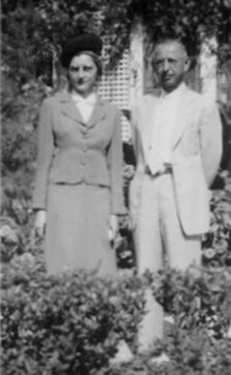 sources that have her husband, Victor Houteff (1885–1955), founder of the Davidian Seventh-day Adventists, as their principal subject. [Image at right] This presents a problem of perspective. Nevertheless, there are some biographical details that are helpful to report here. Florence was born in 1919, the daughter of Eric and Sopha Hermanson and sister to Thomas Oliver Hermanson. Members of the Hermanson family were among the very earliest converts to the Davidian Seventh-day Adventists, a group from which the later Branch Davidians were to emerge. According to a census return dated 1940, Sopha, Thomas Oliver and Florence Hermanson/Houteff were already residing at the Mount Carmel Center in Waco, Texas in 1935, with their earlier place of residence listed as Los Angeles. These details are in full accord with the wider reconstructed narrative of the beginnings of the Davidian Seventh-day Adventists given in secondary sources. Newport, for example, provides evidence that Florence was among the very first group of Davidians to move from California to Texas, a trip that commenced on May 19, 1935 (Newport 2006a:57). Florence’s actual place of birth is listed as Wisconsin. This same census record lists Florence as being the wife of Victor, which makes the reported date of January 1, 1937 entirely plausible (Newport 2006a:58).
sources that have her husband, Victor Houteff (1885–1955), founder of the Davidian Seventh-day Adventists, as their principal subject. [Image at right] This presents a problem of perspective. Nevertheless, there are some biographical details that are helpful to report here. Florence was born in 1919, the daughter of Eric and Sopha Hermanson and sister to Thomas Oliver Hermanson. Members of the Hermanson family were among the very earliest converts to the Davidian Seventh-day Adventists, a group from which the later Branch Davidians were to emerge. According to a census return dated 1940, Sopha, Thomas Oliver and Florence Hermanson/Houteff were already residing at the Mount Carmel Center in Waco, Texas in 1935, with their earlier place of residence listed as Los Angeles. These details are in full accord with the wider reconstructed narrative of the beginnings of the Davidian Seventh-day Adventists given in secondary sources. Newport, for example, provides evidence that Florence was among the very first group of Davidians to move from California to Texas, a trip that commenced on May 19, 1935 (Newport 2006a:57). Florence’s actual place of birth is listed as Wisconsin. This same census record lists Florence as being the wife of Victor, which makes the reported date of January 1, 1937 entirely plausible (Newport 2006a:58).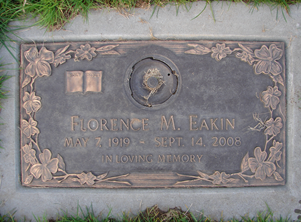 movement. Her ascendency in 1955 was not uncontested however; there were at least three other contenders, including the later founder of the Branch Davidians, Ben Roden (1902–1978) (Newport 2006a:96). Florence occupied the leadership position until her resignation in March 1962. That resignation, which was not Florence’s alone but that of the entire executive council, marked the breakup of the Davidian Seventh-day Adventists into several splinter groups, one of which was to become the Branch Davidians (see further Newport 2006b). Little is known of Florence following this key event. However, it is clear that at some point she married Carl Levi Eakin (1910–1998), whose grave, like that of Florence Marcella Hermanson Eakin, is located at Evergreen Memorial Gardens in Vancouver, Washington. [Image at right] The date of Florence’s death is given as September 14, 2008.
movement. Her ascendency in 1955 was not uncontested however; there were at least three other contenders, including the later founder of the Branch Davidians, Ben Roden (1902–1978) (Newport 2006a:96). Florence occupied the leadership position until her resignation in March 1962. That resignation, which was not Florence’s alone but that of the entire executive council, marked the breakup of the Davidian Seventh-day Adventists into several splinter groups, one of which was to become the Branch Davidians (see further Newport 2006b). Little is known of Florence following this key event. However, it is clear that at some point she married Carl Levi Eakin (1910–1998), whose grave, like that of Florence Marcella Hermanson Eakin, is located at Evergreen Memorial Gardens in Vancouver, Washington. [Image at right] The date of Florence’s death is given as September 14, 2008.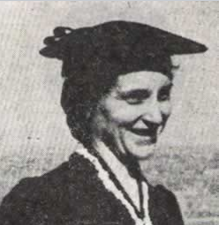 claim that on his deathbed Victor had specifically named her as the chosen successor, a claim that was reinforced by Florence’s brother Thomas Oliver Hermanson. There appear to have been no further witnesses to Victor’s words on this matter, and unsurprisingly it was challenged by some others within the movement, particularly by those who harbored ambition for the highest office themselves. In the end, however, since no one else was able to produce evidence either that Florence had not been so designated or that another claimant had a better case, Florence was appointed to the Vice-Presidency of the group. Victor Houteff’s actual post of President was not again filled as it was one to which only God could appoint.
claim that on his deathbed Victor had specifically named her as the chosen successor, a claim that was reinforced by Florence’s brother Thomas Oliver Hermanson. There appear to have been no further witnesses to Victor’s words on this matter, and unsurprisingly it was challenged by some others within the movement, particularly by those who harbored ambition for the highest office themselves. In the end, however, since no one else was able to produce evidence either that Florence had not been so designated or that another claimant had a better case, Florence was appointed to the Vice-Presidency of the group. Victor Houteff’s actual post of President was not again filled as it was one to which only God could appoint.
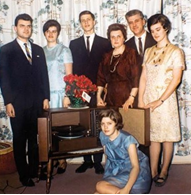 Québec City, Québec. Later, Lac-Etchemin (where a small Marian shrine was built in the 1950s) would acquire a peculiar significance in Giguère’s millennial worldview. A pious young girl, Marie-Paule considered religious life as a missionary in Africa, but her poor health was interpreted by her spiritual advisors as a sign that the Lord was calling her to marriage. In 1944, she married Georges Cliche (1917–1997), with whom she had five children between 1945 and 1952. [Image at right] But the marriage proved a nightmare, with Georges revealing himself to be prodigal, alcoholic, and adulterous. The Church, while opposed to divorce, accepted separation in extreme cases, and several priests suggested that Marie-Paule leave her husband. She did so, reluctantly, in 1957, and later attempts at reconciliation proved unsuccessful, although as an old man Georges would eventually join Marie-Paule’s movement.
Québec City, Québec. Later, Lac-Etchemin (where a small Marian shrine was built in the 1950s) would acquire a peculiar significance in Giguère’s millennial worldview. A pious young girl, Marie-Paule considered religious life as a missionary in Africa, but her poor health was interpreted by her spiritual advisors as a sign that the Lord was calling her to marriage. In 1944, she married Georges Cliche (1917–1997), with whom she had five children between 1945 and 1952. [Image at right] But the marriage proved a nightmare, with Georges revealing himself to be prodigal, alcoholic, and adulterous. The Church, while opposed to divorce, accepted separation in extreme cases, and several priests suggested that Marie-Paule leave her husband. She did so, reluctantly, in 1957, and later attempts at reconciliation proved unsuccessful, although as an old man Georges would eventually join Marie-Paule’s movement.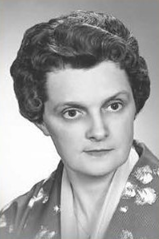 radio stations. In 1954, she supernaturally heard for the first time a reference to “the Army of Mary,” a “wonderful movement” she would later lead (Giguère 1979–1994, 1:174). [Image at right] Slowly, a small Marian group was formed, which included a couple of priests. On August 28, 1971, during a pilgrimage to the Lac-Etchemin shrine, Marie-Paule officially inaugurated the
radio stations. In 1954, she supernaturally heard for the first time a reference to “the Army of Mary,” a “wonderful movement” she would later lead (Giguère 1979–1994, 1:174). [Image at right] Slowly, a small Marian group was formed, which included a couple of priests. On August 28, 1971, during a pilgrimage to the Lac-Etchemin shrine, Marie-Paule officially inaugurated the 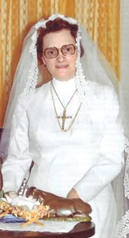 he moved from France to Québec, where he became the editor of the movement’s magazine, L’Étoile (later replaced by Le Royaume). In the years that followed, the Army of Mary gathered thousands of followers in Canada and hundreds more in Europe. The Community of the Sons and Daughters of Mary, a religious order including both priests and nuns, was established in 1981, with Pope John Paul II (1920–2005) personally ordaining the first Son of Mary as a priest in 1986. Several other ordinations followed, and a number of Catholic dioceses throughout the world were happy to welcome both the Sons and the Daughters of Mary to help them in their pastoral work. After her husband’s death in 1997, Marie-Paule herself became a Daughter of Mary, and was subsequently elected Superior General of the congregation as Mère Marie-Paule, later Mère Paul-Marie. [Image at right] A larger “Family of the Sons and Daughters of Mary” also included auxiliary organizations, such as the Oblates-Patriots, established by Marie-Paule in 1986 with the aim of spreading conservative Catholic social teachings, and the Marialys Institute, created in 1992, which gathered together Catholic priests who were not members of the Sons of Mary but shared their general aims.
he moved from France to Québec, where he became the editor of the movement’s magazine, L’Étoile (later replaced by Le Royaume). In the years that followed, the Army of Mary gathered thousands of followers in Canada and hundreds more in Europe. The Community of the Sons and Daughters of Mary, a religious order including both priests and nuns, was established in 1981, with Pope John Paul II (1920–2005) personally ordaining the first Son of Mary as a priest in 1986. Several other ordinations followed, and a number of Catholic dioceses throughout the world were happy to welcome both the Sons and the Daughters of Mary to help them in their pastoral work. After her husband’s death in 1997, Marie-Paule herself became a Daughter of Mary, and was subsequently elected Superior General of the congregation as Mère Marie-Paule, later Mère Paul-Marie. [Image at right] A larger “Family of the Sons and Daughters of Mary” also included auxiliary organizations, such as the Oblates-Patriots, established by Marie-Paule in 1986 with the aim of spreading conservative Catholic social teachings, and the Marialys Institute, created in 1992, which gathered together Catholic priests who were not members of the Sons of Mary but shared their general aims.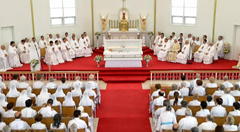 something theologically and canonically impossible in the Roman Catholic Church. On July 11, 2007, the Vatican’s Congregation for the Doctrine of Faith excommunicated those advocating and propagating the doctrines of the Army of Mary.
something theologically and canonically impossible in the Roman Catholic Church. On July 11, 2007, the Vatican’s Congregation for the Doctrine of Faith excommunicated those advocating and propagating the doctrines of the Army of Mary. recuperation from his progressing tuberculosis and Chagres fever. At the same time, she formally joined the Theosophical Society and a month later Judge admitted her to the private Esoteric Section. As it became clearer that Judge’s chronic illness was more serious, Tingley [Image at right] was introduced to a few Theosophists in 1895. Tensions and differences had been building between William Q. Judge and both Annie Besant (1847–1933) and Henry Steel Olcott (1832–1907), who had remained with the parent Theosophical Society headquartered in Adyar, India. There were a complex and contentious series of events, which turned acrimonious at times. This finally came to a head when Judge led the American Section to secede from the Theosophical Society in 1895. Declaring autonomy, the Theosophical Society in America was established and William Q. Judge was elected president for life (Ryan 1975). At that time, Katherine Tingley rapidly moved to the center of governance as Judge’s health declined further.
recuperation from his progressing tuberculosis and Chagres fever. At the same time, she formally joined the Theosophical Society and a month later Judge admitted her to the private Esoteric Section. As it became clearer that Judge’s chronic illness was more serious, Tingley [Image at right] was introduced to a few Theosophists in 1895. Tensions and differences had been building between William Q. Judge and both Annie Besant (1847–1933) and Henry Steel Olcott (1832–1907), who had remained with the parent Theosophical Society headquartered in Adyar, India. There were a complex and contentious series of events, which turned acrimonious at times. This finally came to a head when Judge led the American Section to secede from the Theosophical Society in 1895. Declaring autonomy, the Theosophical Society in America was established and William Q. Judge was elected president for life (Ryan 1975). At that time, Katherine Tingley rapidly moved to the center of governance as Judge’s health declined further. Europe. In Switzerland she met a young Theosophical Society member, Gottfried de Purucker (1874–1942) for the first time. He had joined the Theosophical Society and met Judge who admitted him to the Esoteric Section without the usual probationary period. De Purucker had been to California a few years before and lived in San Diego in 1893, working on a ranch and leading study groups in the Secret Doctrine by the co-founder of the original Theosophical Society, Helena P. Blavatsky (1831–1891). De Purucker helped Tingley identify the land at Point Loma in San Diego for purchase for the UBTS project (PLST Archive). Meanwhile, the Theosophical “crusaders” traveled through the Middle East and sailed on to India. [Image at right] Early one morning near Darjeeling, Tingley evaded her companions and slipped off up into the foothills. She would return a day or so later, stating she had visited one of Blavatsky’s “Teachers” referring to the encounter as “life transforming” (Tingley 1926:155–162; and Tingley 1928). Some years later Tingley would reflect that her encounter with Blavatsky’s young Tibetan “Teacher” in India had given her the courage to continue with establishing and developing the Point Loma community and the gradual alleviation and reversal of symptoms of her chronic Addison’s kidney/adrenal disease. For Katherine Tingley this was a much needed and spiritually life-changing experience, that brought her the energy and motivation to bring her vision of a “White City in the West” into manifestation.
Europe. In Switzerland she met a young Theosophical Society member, Gottfried de Purucker (1874–1942) for the first time. He had joined the Theosophical Society and met Judge who admitted him to the Esoteric Section without the usual probationary period. De Purucker had been to California a few years before and lived in San Diego in 1893, working on a ranch and leading study groups in the Secret Doctrine by the co-founder of the original Theosophical Society, Helena P. Blavatsky (1831–1891). De Purucker helped Tingley identify the land at Point Loma in San Diego for purchase for the UBTS project (PLST Archive). Meanwhile, the Theosophical “crusaders” traveled through the Middle East and sailed on to India. [Image at right] Early one morning near Darjeeling, Tingley evaded her companions and slipped off up into the foothills. She would return a day or so later, stating she had visited one of Blavatsky’s “Teachers” referring to the encounter as “life transforming” (Tingley 1926:155–162; and Tingley 1928). Some years later Tingley would reflect that her encounter with Blavatsky’s young Tibetan “Teacher” in India had given her the courage to continue with establishing and developing the Point Loma community and the gradual alleviation and reversal of symptoms of her chronic Addison’s kidney/adrenal disease. For Katherine Tingley this was a much needed and spiritually life-changing experience, that brought her the energy and motivation to bring her vision of a “White City in the West” into manifestation. debility, but from then until her death, she suffered a kind of emotional agitation at times when under stress. When it became severe, her office staff would call for Gottfried de Purucker to come, given his very calming influence on her in general, and his presence would usually resolve Tingley’s anxieties.
debility, but from then until her death, she suffered a kind of emotional agitation at times when under stress. When it became severe, her office staff would call for Gottfried de Purucker to come, given his very calming influence on her in general, and his presence would usually resolve Tingley’s anxieties.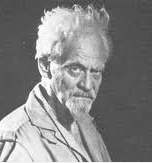 around whether or not that is true. Gardner contended that he was initiated into the New Forest Coven, by Dorothy Clutterbuck in 1939. Members of this coven claimed that theirs was a traditional Wiccan coven whose rituals and practices had been passed down since pre- Christian times.
around whether or not that is true. Gardner contended that he was initiated into the New Forest Coven, by Dorothy Clutterbuck in 1939. Members of this coven claimed that theirs was a traditional Wiccan coven whose rituals and practices had been passed down since pre- Christian times.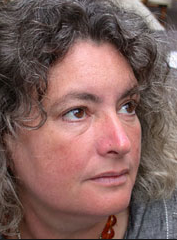 Wicca. She was initiated into the Fairie Tradition of Witchcraft and into Zsuzsanna Budapest’s Feminist Spirituality group. Starhawk’s first book, The Spiral Dance: The Rebirth of the Ancient Religion of the Great Goddess (1979), which brought together both threads of her training, sold over 300,000 copies.(Salomonsen 2002:9). During this same period the religion went from a mystery religion (one in which sacred and magical knowledge is reserved for initiates), with a focus on fertility, to an earth based religion (one that came to see the earth as a manifestation of the Goddess — alive and sacred) ( Clifton 2006:41). These two changes helped to make the religion appealing to those touched by feminism and environmentalism both in the United States and abroad. The religion’s spread was further aided by the publication of relatively inexpensive books and journals and the growth of the Internet.
Wicca. She was initiated into the Fairie Tradition of Witchcraft and into Zsuzsanna Budapest’s Feminist Spirituality group. Starhawk’s first book, The Spiral Dance: The Rebirth of the Ancient Religion of the Great Goddess (1979), which brought together both threads of her training, sold over 300,000 copies.(Salomonsen 2002:9). During this same period the religion went from a mystery religion (one in which sacred and magical knowledge is reserved for initiates), with a focus on fertility, to an earth based religion (one that came to see the earth as a manifestation of the Goddess — alive and sacred) ( Clifton 2006:41). These two changes helped to make the religion appealing to those touched by feminism and environmentalism both in the United States and abroad. The religion’s spread was further aided by the publication of relatively inexpensive books and journals and the growth of the Internet.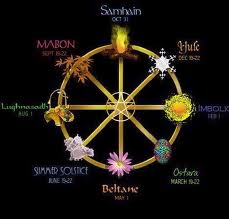 relationship between the Goddess and the God as portrayed in the rituals. The Goddess is viewed as eternal but changing from the maid, to mother, to crone; then, in the spiral of time, she returns in the spring as a young woman. The God is born of the mother in midwinter, becomes her consort in the spring, dies to ensure the growth of crops in the fall; then he is reborn at the winter solstice. The God is portrayed with horns, a sign of virility. The image is an old one that was converted to the image of the Devil within Christianity. All goddesses are viewed as aspects of the one Goddess just as all gods are believed to be aspects of the one God.
relationship between the Goddess and the God as portrayed in the rituals. The Goddess is viewed as eternal but changing from the maid, to mother, to crone; then, in the spiral of time, she returns in the spring as a young woman. The God is born of the mother in midwinter, becomes her consort in the spring, dies to ensure the growth of crops in the fall; then he is reborn at the winter solstice. The God is portrayed with horns, a sign of virility. The image is an old one that was converted to the image of the Devil within Christianity. All goddesses are viewed as aspects of the one Goddess just as all gods are believed to be aspects of the one God.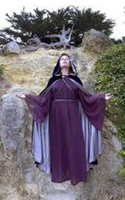 directed toward a cause, such as healing someone or finding a job, parking place, or rental apartment. It is believed that the energy that an individual sends out will return to her/him three-fold and hence the most common form of magic is healing magic. Performing healing both helps to show that the Witch has magical power and that s/he uses it for good ( Crowley 2000:151-56). For Wiccans the world is viewed as magical. It is commonly believed that the Goddess or the God may send an individual a sign or give them direction in life. These may come during a ritual or meditation or in the course of everyday life as people happen upon old friends or find something in the sand at the beach that they believe is of import. Magic therefore is a way of connecting with the divine and with nature. Magic is viewed as part of the natural world and indicative of individuals’ connection to nature, to one another, and to the divine.
directed toward a cause, such as healing someone or finding a job, parking place, or rental apartment. It is believed that the energy that an individual sends out will return to her/him three-fold and hence the most common form of magic is healing magic. Performing healing both helps to show that the Witch has magical power and that s/he uses it for good ( Crowley 2000:151-56). For Wiccans the world is viewed as magical. It is commonly believed that the Goddess or the God may send an individual a sign or give them direction in life. These may come during a ritual or meditation or in the course of everyday life as people happen upon old friends or find something in the sand at the beach that they believe is of import. Magic therefore is a way of connecting with the divine and with nature. Magic is viewed as part of the natural world and indicative of individuals’ connection to nature, to one another, and to the divine.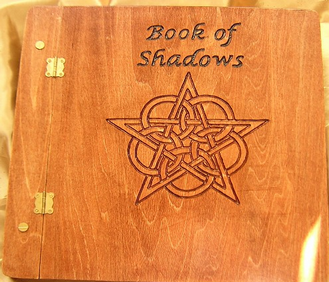
 knife). Because Wiccans do not normally have churches, they need to create sacred space for the ritual in what is normally mundane space. This is done in covens by the High Priestess and High Priest walking around the circle while extending athames out in front of them and chanting. Participants visualize a blue or white light radiating up in a sphere to create a safe and sacred place. The High Priestess and High Priest then call in or invoke the watchtower, that is, the powers of the four directions (east, south, west and north) and the deities associated with each of those. They normally consecrate the circle and the participants with elements that are associated with each of these directions, which are placed on an altar in the center of the circle (Adler 1986:105-106). Altars are typically decorated to reflect the ritual being celebrated. For example, at Samhain, when death is celebrated as part of the cycle of life, pictures of deceased relatives and friends may decorate the altar; on May Day (May 1 st) there would be fresh flowers and fruit on the altar, symbolizing new life and fertility.
knife). Because Wiccans do not normally have churches, they need to create sacred space for the ritual in what is normally mundane space. This is done in covens by the High Priestess and High Priest walking around the circle while extending athames out in front of them and chanting. Participants visualize a blue or white light radiating up in a sphere to create a safe and sacred place. The High Priestess and High Priest then call in or invoke the watchtower, that is, the powers of the four directions (east, south, west and north) and the deities associated with each of those. They normally consecrate the circle and the participants with elements that are associated with each of these directions, which are placed on an altar in the center of the circle (Adler 1986:105-106). Altars are typically decorated to reflect the ritual being celebrated. For example, at Samhain, when death is celebrated as part of the cycle of life, pictures of deceased relatives and friends may decorate the altar; on May Day (May 1 st) there would be fresh flowers and fruit on the altar, symbolizing new life and fertility.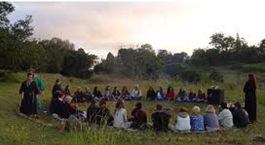 particular celebration is then conducted. The Circle also serves to contain energy that is built up during the rites until it is ready to be released in what is known as the Cone of Power. Singing, dancing, meditation, and chanting can all be used by Wiccans to raise power during a ritual. The cone of power is released for a purpose set by the Wiccan practitioners. There can be one shared purpose, such as healing a particular person or the rainforest, or each person may have his or her own particular magical purpose (Berger 1999:31). The ceremony ends with a cup of wine being raised and an athame dipped into it, symbolizing the union between the Goddess and the God. The wine is then passed around the Circle with the words “Blessed Be” and drunk by the practitioners. Cakes are blessed by the High Priestess and Priest; they are also passed around with the words “blessed be” and then eaten (Adler 1986:168). Sometimes rituals are conducted naked (skyclad) or in ritual robes, depending on the Wiccan tradition and the place the ritual is conducted. Outdoor or public rituals are normally conducted in robes or street clothes. At the end of the rites, the Circle is opened and the Watchtowers are symbolically taken down. Traditionally, people then share a meal, as eating is seen as needed to ground participants (i.e., help them leave a magical state and return to the mundane world).
particular celebration is then conducted. The Circle also serves to contain energy that is built up during the rites until it is ready to be released in what is known as the Cone of Power. Singing, dancing, meditation, and chanting can all be used by Wiccans to raise power during a ritual. The cone of power is released for a purpose set by the Wiccan practitioners. There can be one shared purpose, such as healing a particular person or the rainforest, or each person may have his or her own particular magical purpose (Berger 1999:31). The ceremony ends with a cup of wine being raised and an athame dipped into it, symbolizing the union between the Goddess and the God. The wine is then passed around the Circle with the words “Blessed Be” and drunk by the practitioners. Cakes are blessed by the High Priestess and Priest; they are also passed around with the words “blessed be” and then eaten (Adler 1986:168). Sometimes rituals are conducted naked (skyclad) or in ritual robes, depending on the Wiccan tradition and the place the ritual is conducted. Outdoor or public rituals are normally conducted in robes or street clothes. At the end of the rites, the Circle is opened and the Watchtowers are symbolically taken down. Traditionally, people then share a meal, as eating is seen as needed to ground participants (i.e., help them leave a magical state and return to the mundane world).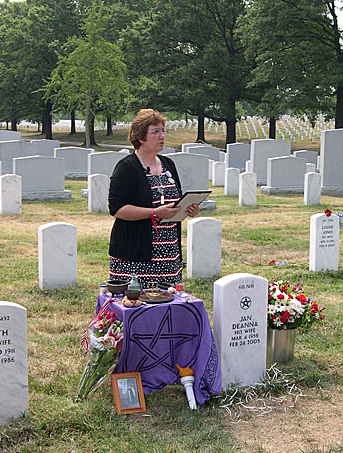 religious freedom. Wiccans have won a number of court cases resulting in the pentagram being an accepted symbol on graves in military cemeteries, and, recently in California, the recognition that Wiccan prisoners must be provided with their own clergy (Dolan 2013). Nonetheless, there continues to be discrimination. For example, on Sunday, February 17, 2013 Friends of Fox anchors mocked Wicca when reporting that the University of Missouri recognized all Wiccan holidays (in reality only the Sabbats were recognized). The three anchors went on to proclaim Wiccans were either dungeons and dragons players or twice divorced middle-aged women who live in rural areas, are mid-wives and like incense. This portrait is both demeaning and inaccurate as all research indicates that while most Wiccans are women, they tend to live in urban and suburban areas and are as likely to be young as middle aged, and tend to be better educated than the general American public (Berger 2003:25-34). After a protest lead mostly by Selena Fox of Circle Sanctuary, the network apologized. Nonetheless most Wiccan believe that negative images, such as the one presented on Fox news, are common and can affect individuals’ chances of promotions and their ability to take time from work to celebrate their religious holidays. However, there does appear to be a shift from Wiccans being seen as dangerous devil worshippers to being regarded as silly but harmless. Many Wiccans have been working to have their religion recognized as a legitimate and serious practice. They are active in inter-faith work and participate in the World Parliament of Religions.
religious freedom. Wiccans have won a number of court cases resulting in the pentagram being an accepted symbol on graves in military cemeteries, and, recently in California, the recognition that Wiccan prisoners must be provided with their own clergy (Dolan 2013). Nonetheless, there continues to be discrimination. For example, on Sunday, February 17, 2013 Friends of Fox anchors mocked Wicca when reporting that the University of Missouri recognized all Wiccan holidays (in reality only the Sabbats were recognized). The three anchors went on to proclaim Wiccans were either dungeons and dragons players or twice divorced middle-aged women who live in rural areas, are mid-wives and like incense. This portrait is both demeaning and inaccurate as all research indicates that while most Wiccans are women, they tend to live in urban and suburban areas and are as likely to be young as middle aged, and tend to be better educated than the general American public (Berger 2003:25-34). After a protest lead mostly by Selena Fox of Circle Sanctuary, the network apologized. Nonetheless most Wiccan believe that negative images, such as the one presented on Fox news, are common and can affect individuals’ chances of promotions and their ability to take time from work to celebrate their religious holidays. However, there does appear to be a shift from Wiccans being seen as dangerous devil worshippers to being regarded as silly but harmless. Many Wiccans have been working to have their religion recognized as a legitimate and serious practice. They are active in inter-faith work and participate in the World Parliament of Religions.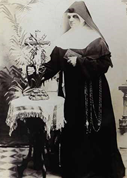 and several friends pledged to join a religious order. However, Brise continued to live with her parents in what was a relatively poor family until 1855 when the family emigrated to America. The family purchased a 240 acre tract of land to support itself. It was four years later, in October, 1859, just a short time after the Marian apparitions at Lourdes, that Brise had the first of three apparitional experiences. She was carrying grain to a mill in Champion, Wisconsin when the Virgin Mary appeared to her: “She saw a lady clothed in dazzling white, with a yellow sash around her waist and a crown of stars around her head standing between two trees, one a maple, the other a hemlock” (Shrine 2010). Brise found the experience frightening. On Sunday, October 9, the second apparitional event occurred when Brise was walking to Mass in Bay Settlement, a neighboring area, with two companions. Only Brise directly experienced the apparition. Finally, when walking home from church, Brise experienced an apparitional figure in the same place for a third and final time. Mary identified herself as the “Queen of Heaven” and told Brise that she must teach the children how to live their lives for God. From that day forward, Brise devoted her life to the teachings of the Catholic faith to young
and several friends pledged to join a religious order. However, Brise continued to live with her parents in what was a relatively poor family until 1855 when the family emigrated to America. The family purchased a 240 acre tract of land to support itself. It was four years later, in October, 1859, just a short time after the Marian apparitions at Lourdes, that Brise had the first of three apparitional experiences. She was carrying grain to a mill in Champion, Wisconsin when the Virgin Mary appeared to her: “She saw a lady clothed in dazzling white, with a yellow sash around her waist and a crown of stars around her head standing between two trees, one a maple, the other a hemlock” (Shrine 2010). Brise found the experience frightening. On Sunday, October 9, the second apparitional event occurred when Brise was walking to Mass in Bay Settlement, a neighboring area, with two companions. Only Brise directly experienced the apparition. Finally, when walking home from church, Brise experienced an apparitional figure in the same place for a third and final time. Mary identified herself as the “Queen of Heaven” and told Brise that she must teach the children how to live their lives for God. From that day forward, Brise devoted her life to the teachings of the Catholic faith to young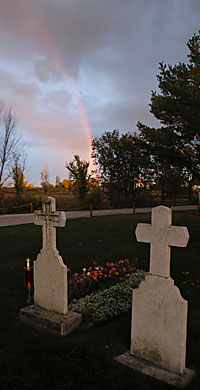 seemed uncertain. The school suffered without her presence and was passed into the hands of Sr. Pauline LaPlante, an original member of the Sisters of St. Francis of the Holy Cross of Bay Settlement (Kasten 2010). She worked to continue the school until her death in 1926 (Mann 2011). In the following years the school changed hands and faces several times. In 1933, it was remodeled as the Home for Crippled Children, and then in 1953, Bishop Paul Rhode discontinued the home and turned it into a pre-noviate high school for the Bay Settlement Sisters. In 1990, it became a House of Prayer for the Bay Settlement Sisters until 1990 when the diocese gained control of the grounds. The diocese converted the property into a shrine and welcomed in a group of Carmelite Sisters who founded the Carmel of the Holy Name of Jesus in 1992 (Kasten 2010). Ten years later the Carmel moved on to rural Denmark.
seemed uncertain. The school suffered without her presence and was passed into the hands of Sr. Pauline LaPlante, an original member of the Sisters of St. Francis of the Holy Cross of Bay Settlement (Kasten 2010). She worked to continue the school until her death in 1926 (Mann 2011). In the following years the school changed hands and faces several times. In 1933, it was remodeled as the Home for Crippled Children, and then in 1953, Bishop Paul Rhode discontinued the home and turned it into a pre-noviate high school for the Bay Settlement Sisters. In 1990, it became a House of Prayer for the Bay Settlement Sisters until 1990 when the diocese gained control of the grounds. The diocese converted the property into a shrine and welcomed in a group of Carmelite Sisters who founded the Carmel of the Holy Name of Jesus in 1992 (Kasten 2010). Ten years later the Carmel moved on to rural Denmark.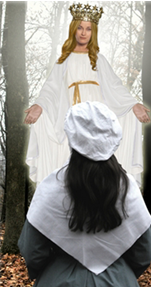 three at the site that would come to be known as Our Lady of Good Help. It was at the third apparitional event, which occurred while Brise was returning home from church that she received her spiritual mission (Shrine 2010; Kasten 2010). Brise reported that she asked the figure “In God’s name who are you and what do you want of me?” Mary reportedly then told Brise that she was the Queen of Heaven and assigned Brise a mission: “I am the Queen of Heaven who prays for the conversion of sinners, and I wish you to do the same. You received Holy Communion this morning and that is well. But you must do more. Make a general confession and offer Communion for the conversion of sinners. If they do not convert and do penance, my Son will be obliged to punish them.” Mary then offer more specific instructions: “Gather the children in this wild country and teach them what they should know for salvation.” When Brise inquired how she might accomplish this mission with little knowledge, Mary responded: “Teach them their catechism, how to sign themselves with the sign of the Cross, and how to approach the sacraments; that is what I wish you to do. Go and fear nothing. I will help you.”
three at the site that would come to be known as Our Lady of Good Help. It was at the third apparitional event, which occurred while Brise was returning home from church that she received her spiritual mission (Shrine 2010; Kasten 2010). Brise reported that she asked the figure “In God’s name who are you and what do you want of me?” Mary reportedly then told Brise that she was the Queen of Heaven and assigned Brise a mission: “I am the Queen of Heaven who prays for the conversion of sinners, and I wish you to do the same. You received Holy Communion this morning and that is well. But you must do more. Make a general confession and offer Communion for the conversion of sinners. If they do not convert and do penance, my Son will be obliged to punish them.” Mary then offer more specific instructions: “Gather the children in this wild country and teach them what they should know for salvation.” When Brise inquired how she might accomplish this mission with little knowledge, Mary responded: “Teach them their catechism, how to sign themselves with the sign of the Cross, and how to approach the sacraments; that is what I wish you to do. Go and fear nothing. I will help you.” held four times a day in the chapel for those who wish for more than just individual reflection on site. Pilgrims testify to the extraordinary qualities of the site: “’It’s incredible — she’s here, you just feel it’, Ms. Banda said after praying in the crypt chapel, said to be on the spot of the apparitions. As they passed a statue of Mary in white, just as described by Ms. Brise, Ms. Banda was overcome with emotion, weeping and hugging her mother. The two of them went back to pray some more” (Eckholm 2010). Another pilgrim stated that “There’s a lot of power here….You can feel the presence of Mary, and it feels like she’s listening to you” (Eckholm 2010). Many crutches and canes are left behind at the shrine’s crypt. The owners of these items leave them saying that they no longer need their assistance.
held four times a day in the chapel for those who wish for more than just individual reflection on site. Pilgrims testify to the extraordinary qualities of the site: “’It’s incredible — she’s here, you just feel it’, Ms. Banda said after praying in the crypt chapel, said to be on the spot of the apparitions. As they passed a statue of Mary in white, just as described by Ms. Brise, Ms. Banda was overcome with emotion, weeping and hugging her mother. The two of them went back to pray some more” (Eckholm 2010). Another pilgrim stated that “There’s a lot of power here….You can feel the presence of Mary, and it feels like she’s listening to you” (Eckholm 2010). Many crutches and canes are left behind at the shrine’s crypt. The owners of these items leave them saying that they no longer need their assistance.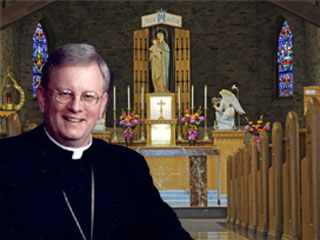 (“Wisconsin Site” 2011). He stated that “I declare with moral certainty and in accord with the norms of the Church that the events, apparitions and locutions given to Adele Brise in October of 1859 do exhibit the substance of supernatural character, and I do hereby approve these apparitions as worthy of belief (although not obligatory) by the Christian faithful” (“Marian Apparitions” 2010).
(“Wisconsin Site” 2011). He stated that “I declare with moral certainty and in accord with the norms of the Church that the events, apparitions and locutions given to Adele Brise in October of 1859 do exhibit the substance of supernatural character, and I do hereby approve these apparitions as worthy of belief (although not obligatory) by the Christian faithful” (“Marian Apparitions” 2010).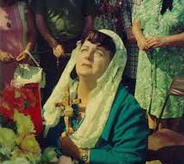 Marian seer. Lueken’s first mystical experiences followed the assassination of Senator Robert Kennedy on June 5, 1968. The next day, as Kennedy lay in the hospital, Lueken was praying for his recovery when she felt herself surrounded by an overwhelming fragrance of roses. Although the senator died late that night, the inexplicable smell of roses continued to haunt her. Soon she would wake up to find she had written poetry that she could not remember writing. She had prayed to St. Therese of Lisieux to save senator Kennedy and suspected that Therese was somehow the true author of these poems. She discussed these experiences with the priests at her parish church, St. Robert Bellarmine’s, but she felt they did not take her seriously. Her husband, Arthur, also discouraged any discussion of miracles.
Marian seer. Lueken’s first mystical experiences followed the assassination of Senator Robert Kennedy on June 5, 1968. The next day, as Kennedy lay in the hospital, Lueken was praying for his recovery when she felt herself surrounded by an overwhelming fragrance of roses. Although the senator died late that night, the inexplicable smell of roses continued to haunt her. Soon she would wake up to find she had written poetry that she could not remember writing. She had prayed to St. Therese of Lisieux to save senator Kennedy and suspected that Therese was somehow the true author of these poems. She discussed these experiences with the priests at her parish church, St. Robert Bellarmine’s, but she felt they did not take her seriously. Her husband, Arthur, also discouraged any discussion of miracles. Bellarmine’s church in Bayside “when the roses are in bloom.” On the night of June 18, 1970, Lueken knelt alone in the rain praying the rosary before a statue of the Immaculate Conception outside her church. Here, Mary appeared to Lueken and instructed her that she was a bride of Christ, that she wept for the sins of the world, and that everyone must return to saying the rosary. Lueken announced that a national shrine should be built on the church grounds and that Mary would henceforth appear there on every Catholic feast day. Over the next two years, a small body of followers joined Lueken in her vigils in front of the statue. At each appearance, Lueken would deliver a “message from heaven,” spoken through her by Mary as well as a growing cast of saints and angels. These messages typically included jeremiads about the weight of America’s sins and warnings of a coming chastisement (Lueken 1998: vol. 1).
Bellarmine’s church in Bayside “when the roses are in bloom.” On the night of June 18, 1970, Lueken knelt alone in the rain praying the rosary before a statue of the Immaculate Conception outside her church. Here, Mary appeared to Lueken and instructed her that she was a bride of Christ, that she wept for the sins of the world, and that everyone must return to saying the rosary. Lueken announced that a national shrine should be built on the church grounds and that Mary would henceforth appear there on every Catholic feast day. Over the next two years, a small body of followers joined Lueken in her vigils in front of the statue. At each appearance, Lueken would deliver a “message from heaven,” spoken through her by Mary as well as a growing cast of saints and angels. These messages typically included jeremiads about the weight of America’s sins and warnings of a coming chastisement (Lueken 1998: vol. 1). The Pilgrims were also known as “the White Berets” for the hats they wore. Like Lueken, they were disturbed by the reforms of Vatican II. The White Berets declared Lueken to be “the seer of the age” and printed her messages from heaven in their newsletter. They also began organizing buses that transported hundreds of pilgrims to attend vigils in front of Lueken’s parish church. Lueken’s messages began to hint at global conspiracies, a coming nuclear war, and a celestial body called “The Fiery Ball of Redemption” that would soon strike the Earth, causing planet-wide destruction.
The Pilgrims were also known as “the White Berets” for the hats they wore. Like Lueken, they were disturbed by the reforms of Vatican II. The White Berets declared Lueken to be “the seer of the age” and printed her messages from heaven in their newsletter. They also began organizing buses that transported hundreds of pilgrims to attend vigils in front of Lueken’s parish church. Lueken’s messages began to hint at global conspiracies, a coming nuclear war, and a celestial body called “The Fiery Ball of Redemption” that would soon strike the Earth, causing planet-wide destruction.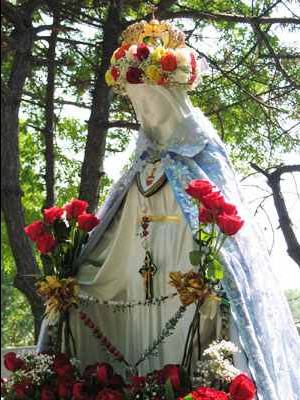
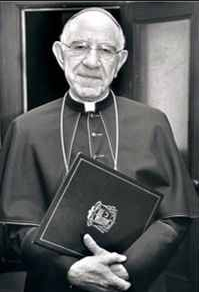 contradicted Catholic doctrine (Goldman 1987). Mugavero’s findings were sent to three hundred bishops throughout the United States and one hundred conferences of bishops around the world. Despite this censure from Church authorities, Lueken’s followers still identify as Catholics in good standing and they defend their views citing canon law. They contend that Lueken’s visions never received a proper investigation led by a bishop, and that the diocese’s dismissal of Lueken is therefore not legitimate. If anyone has violated Church law, they argue, it is the modernists whom Lueken condemned for receiving communion in the hand and other ritual transgressions that go against long-established Catholic tradition.
contradicted Catholic doctrine (Goldman 1987). Mugavero’s findings were sent to three hundred bishops throughout the United States and one hundred conferences of bishops around the world. Despite this censure from Church authorities, Lueken’s followers still identify as Catholics in good standing and they defend their views citing canon law. They contend that Lueken’s visions never received a proper investigation led by a bishop, and that the diocese’s dismissal of Lueken is therefore not legitimate. If anyone has violated Church law, they argue, it is the modernists whom Lueken condemned for receiving communion in the hand and other ritual transgressions that go against long-established Catholic tradition.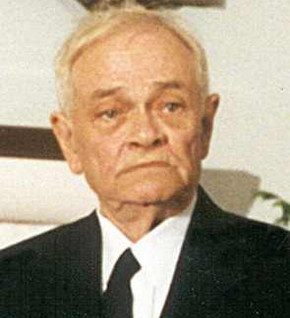 pilgrimages to Flushing Meadows with followers from around the world. But in 1997, a schism occurred between the shrine’s director, Michael Mangan, and Lueken’s widower, Arthur Lueken. A judge ruled in favor of Arthur Lueken, declaring him president of Our Lady of the Roses Shrine (OLR) and awarding him all of the organization’s assets and facilities. Undaunted, Mangan formed his own group, Saint Michael’s World Apostolate (SMWA). Both groups continued to arrive at the movement’s sacred site in Flushing Meadows where they held rival vigils. Once again, police were sent out to keep the peace (Kilgannon 2003). Today, this conflict has thawed into a detente. Their celebrations of Catholic feast days are sometimes timed such that only one group will be present in the park on a given day. For events where both groups must be present, such as Sunday morning holy hour, they alternate which group will have access to the monument. One group may set its statue of the Virgin Mary on the Vatican Monument, the other must use a nearby traffic island. The rival groups have decided it is in everyone’s interests to appear professional while in the park.
pilgrimages to Flushing Meadows with followers from around the world. But in 1997, a schism occurred between the shrine’s director, Michael Mangan, and Lueken’s widower, Arthur Lueken. A judge ruled in favor of Arthur Lueken, declaring him president of Our Lady of the Roses Shrine (OLR) and awarding him all of the organization’s assets and facilities. Undaunted, Mangan formed his own group, Saint Michael’s World Apostolate (SMWA). Both groups continued to arrive at the movement’s sacred site in Flushing Meadows where they held rival vigils. Once again, police were sent out to keep the peace (Kilgannon 2003). Today, this conflict has thawed into a detente. Their celebrations of Catholic feast days are sometimes timed such that only one group will be present in the park on a given day. For events where both groups must be present, such as Sunday morning holy hour, they alternate which group will have access to the monument. One group may set its statue of the Virgin Mary on the Vatican Monument, the other must use a nearby traffic island. The rival groups have decided it is in everyone’s interests to appear professional while in the park. have been a trope in Marian apparitions since the nineteenth century. Lueken’s visions repeatedly described a fiery celestial object called “The Ball of Redemption” (possibly a comet, although this is not clear), that will collide with the Earth, killing much of the population. Her visions also describe World War III, which will include a full nuclear exchange. Horrifying descriptions of nuclear war have also been common in Marian Apparitions since the start of the Cold War. Unlike Protestant dispensationalism, Baysiders believe that the Chastisement can be postponed through prayer. When prophecies do not come to pass, Baysiders often take credit for earning the world a reprieve from judgment.
have been a trope in Marian apparitions since the nineteenth century. Lueken’s visions repeatedly described a fiery celestial object called “The Ball of Redemption” (possibly a comet, although this is not clear), that will collide with the Earth, killing much of the population. Her visions also describe World War III, which will include a full nuclear exchange. Horrifying descriptions of nuclear war have also been common in Marian Apparitions since the start of the Cold War. Unlike Protestant dispensationalism, Baysiders believe that the Chastisement can be postponed through prayer. When prophecies do not come to pass, Baysiders often take credit for earning the world a reprieve from judgment.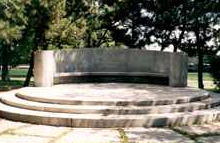 Hour” every Sunday that is dedicated to prayer for the priesthood. These events are held around a monument built in Flushing Meadows Park as part of the Vatican Pavilion during the 1964 World’s Fair. The monument, known as The Excedra, is a simple curved bench resembling an unrolling scroll. During vigils, the monument is transformed into a shrine. A fiberglass statue of Mary is ensconced on top of the bench and surrounded with by candles, flags representing the United States and the Vatican, and other ritual objects. The grounds are also consecrated with holy water.
Hour” every Sunday that is dedicated to prayer for the priesthood. These events are held around a monument built in Flushing Meadows Park as part of the Vatican Pavilion during the 1964 World’s Fair. The monument, known as The Excedra, is a simple curved bench resembling an unrolling scroll. During vigils, the monument is transformed into a shrine. A fiberglass statue of Mary is ensconced on top of the bench and surrounded with by candles, flags representing the United States and the Vatican, and other ritual objects. The grounds are also consecrated with holy water.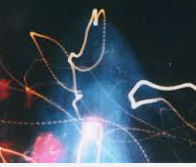 movement coincided with the development of Polaroid cameras. Many pilgrims took Polaroids during the vigils and found anomalies in the film. Most of these effects are easily attributable to user error or to ambient light sources like candles or car lights. Some, however, are more spectacular and difficult to explain. These anomalies were regarded as messages from heaven (Wojcik 1996, 2009). While Lueken was alive, people could bring her their “miraculous Polaroids” and she would interpret the streaks and blurs that appeared on the film, finding their symbolic significance (Chute and Simpson 1976). Today, ordinary Baysiders have developed codes to interpret the anomalies. During vigils, pilgrims take many photos and continue to find anomalies. While digital cameras are used, some Pilgrims prefer to use vintage Polaroid cameras like those used during the original vigils. Discovering a “message from heaven” in a photograph can be a source of great personal meaning for some Baysiders.
movement coincided with the development of Polaroid cameras. Many pilgrims took Polaroids during the vigils and found anomalies in the film. Most of these effects are easily attributable to user error or to ambient light sources like candles or car lights. Some, however, are more spectacular and difficult to explain. These anomalies were regarded as messages from heaven (Wojcik 1996, 2009). While Lueken was alive, people could bring her their “miraculous Polaroids” and she would interpret the streaks and blurs that appeared on the film, finding their symbolic significance (Chute and Simpson 1976). Today, ordinary Baysiders have developed codes to interpret the anomalies. During vigils, pilgrims take many photos and continue to find anomalies. While digital cameras are used, some Pilgrims prefer to use vintage Polaroid cameras like those used during the original vigils. Discovering a “message from heaven” in a photograph can be a source of great personal meaning for some Baysiders.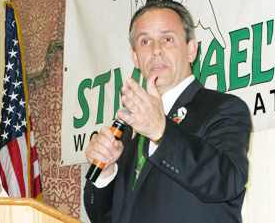 Park. Saint Michael’s World Apostolate is the larger group, which is led by Michael Mangan. Although a court awarded the name “Our Lady of the Roses Shrine” to Veronica Lueken’s widower, Mangan’s group had more support from pilgrims and acquired more infrastructure. When Our Lady of the Roses Shrine was unable to maintain their printing presses, Mangan’s group arranged to buy them. Saint Michael’s World Apostolate is headed by a group of men called the Lay Order of Saint Michael, who live together in a religious community. They are supported by numerous shrine workers who help to raise funds, disseminate the messages, and organize vigils.
Park. Saint Michael’s World Apostolate is the larger group, which is led by Michael Mangan. Although a court awarded the name “Our Lady of the Roses Shrine” to Veronica Lueken’s widower, Mangan’s group had more support from pilgrims and acquired more infrastructure. When Our Lady of the Roses Shrine was unable to maintain their printing presses, Mangan’s group arranged to buy them. Saint Michael’s World Apostolate is headed by a group of men called the Lay Order of Saint Michael, who live together in a religious community. They are supported by numerous shrine workers who help to raise funds, disseminate the messages, and organize vigils.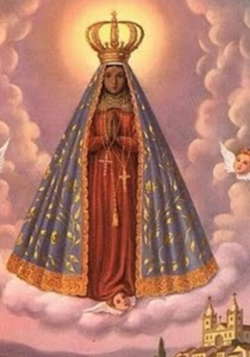 Our Lady of the Immaculate Conception, the Virgin Mary. They named her Our Lady of the Conception Who Appeared from the Waters, which was subsequently shortened to Our Lady Aparecida. The men wrapped her in cloth, continued fishing, and soon had enough fish to provide a sumptuous feast. The appearance of Our Lady of Aparecida came to be regarded as a double miracle. To the faithful, it was miraculous, first, that the fishermen found both the body and the head of the statue simultaneously and, second, that finding the statue was followed by a bountiful harvest of fish. This miracle resonates with a biblical narrative in which Jesus appears to unsuccessful fishermen, telling them to cast their nets again, which leads them to an abundant catch.
Our Lady of the Immaculate Conception, the Virgin Mary. They named her Our Lady of the Conception Who Appeared from the Waters, which was subsequently shortened to Our Lady Aparecida. The men wrapped her in cloth, continued fishing, and soon had enough fish to provide a sumptuous feast. The appearance of Our Lady of Aparecida came to be regarded as a double miracle. To the faithful, it was miraculous, first, that the fishermen found both the body and the head of the statue simultaneously and, second, that finding the statue was followed by a bountiful harvest of fish. This miracle resonates with a biblical narrative in which Jesus appears to unsuccessful fishermen, telling them to cast their nets again, which leads them to an abundant catch.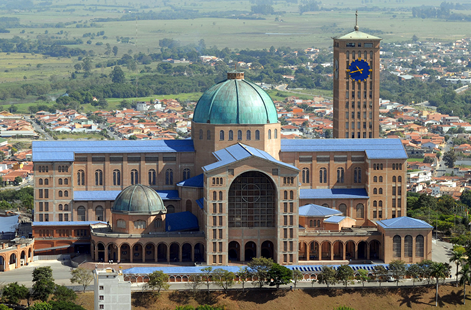 of Aparecida on May 31 of the next year. In 1931, Getulio Vargas seized power in Brazil after a military coup d’etat. While in power he sought to create a unified Brazil and so promoted a semi-official Catholic Church with Our Lady of Aparecida as its sign. Vargas’s reign as dictator ended in 1945, but by then the plans were already underway for a new basilica. In 1959, Our Lady of Aparecida was moved to the unfinished building. In the meantime, after a period of civilian government, military rule returned in 1964. Catello Branco, who was designated as president, symbolically named Our Lady of Aparecida to be the highest general of the Brazilian Army in an attempt to restrict how public spaces could be used. When the new basilica was finally completed in 1980, Pope John Paul II visited and blessed her shrine. His visit led to the creation of a law which named October 12, her likely date of discovery, an official national Brazilian holiday. The mixing of religious and political legitimation for Our Lady of Aparecida has been controversial but has also meant that Our Lady has been not only a symbol of the Catholic Church but also of Brazil as a nation (Johnson 1997:129).
of Aparecida on May 31 of the next year. In 1931, Getulio Vargas seized power in Brazil after a military coup d’etat. While in power he sought to create a unified Brazil and so promoted a semi-official Catholic Church with Our Lady of Aparecida as its sign. Vargas’s reign as dictator ended in 1945, but by then the plans were already underway for a new basilica. In 1959, Our Lady of Aparecida was moved to the unfinished building. In the meantime, after a period of civilian government, military rule returned in 1964. Catello Branco, who was designated as president, symbolically named Our Lady of Aparecida to be the highest general of the Brazilian Army in an attempt to restrict how public spaces could be used. When the new basilica was finally completed in 1980, Pope John Paul II visited and blessed her shrine. His visit led to the creation of a law which named October 12, her likely date of discovery, an official national Brazilian holiday. The mixing of religious and political legitimation for Our Lady of Aparecida has been controversial but has also meant that Our Lady has been not only a symbol of the Catholic Church but also of Brazil as a nation (Johnson 1997:129).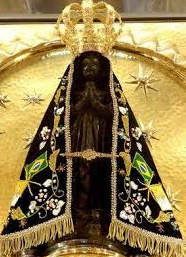 was first moved into its prayer chapel near the river, miraculous events were reported: candles that blew out in the chapel would relight, a slave running from a cruel master prayed to the idol for freedom and his chains were released, a blind girl received sight, and a man who wished to harm the statue found his horse’s feet “locked fast to the ground at the entrance of the building” when he tried to enter the chapel (“Our Lady Aparecida” n.d.). Further, while the new basilica was being constructed, it was reported that the every evening the statue was moved to reside in the in progressing Basilica, but every morning, she would appear back in the old Basilica. This went on for several years. Eventually, it is believed, the statue gave up and realized that no member of the clergy was going to heed her desire to remain at her old resting place.
was first moved into its prayer chapel near the river, miraculous events were reported: candles that blew out in the chapel would relight, a slave running from a cruel master prayed to the idol for freedom and his chains were released, a blind girl received sight, and a man who wished to harm the statue found his horse’s feet “locked fast to the ground at the entrance of the building” when he tried to enter the chapel (“Our Lady Aparecida” n.d.). Further, while the new basilica was being constructed, it was reported that the every evening the statue was moved to reside in the in progressing Basilica, but every morning, she would appear back in the old Basilica. This went on for several years. Eventually, it is believed, the statue gave up and realized that no member of the clergy was going to heed her desire to remain at her old resting place.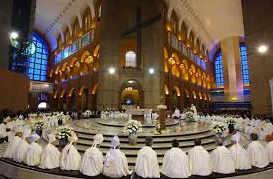 wherein the pilgrims may promise to accomplish something in the name of Our Lady of Aparecida if she will grant them something. The second is a Territorial Bond, wherein pilgrims bring items to be blessed by the statue to improve their relationship with Aparecida. Finally, there is Inclusion, which connotes that, while there are many rituals associated with Catholic Saints, all of them are related and equally important. This is directly contrasted, though, by the attitudes of pilgrims who come to see the idol. They generally arrive to visit the statue and nothing more. They do not confess their sins or hold much stock in the other aspects of Catholicism. In their minds, the statue of Our Lady of Aparecida is the only reality they need.
wherein the pilgrims may promise to accomplish something in the name of Our Lady of Aparecida if she will grant them something. The second is a Territorial Bond, wherein pilgrims bring items to be blessed by the statue to improve their relationship with Aparecida. Finally, there is Inclusion, which connotes that, while there are many rituals associated with Catholic Saints, all of them are related and equally important. This is directly contrasted, though, by the attitudes of pilgrims who come to see the idol. They generally arrive to visit the statue and nothing more. They do not confess their sins or hold much stock in the other aspects of Catholicism. In their minds, the statue of Our Lady of Aparecida is the only reality they need.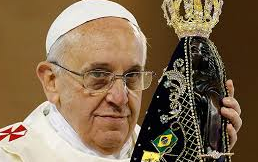 around her shoulders and a large crown adorns her head), what honors and special titles she has been given, and the official date for her celebration are controlled by various units of the Catholic church, one might say that actual leadership resides with the pilgrims. When Pope John Paul II visited Brazil in 1980 and great preparation was made to receive the expected increase in pilgrims to Aparecida to coincide with his visit, officials were surprised when no more than the normal 300,000 appeared, as opposed to the 2,000,000 who were expected. It seems that the pilgrims intended to follow their traditional schedules with regard to the Lady and to wait until the Pope visited their own locales to pay tribute to him.
around her shoulders and a large crown adorns her head), what honors and special titles she has been given, and the official date for her celebration are controlled by various units of the Catholic church, one might say that actual leadership resides with the pilgrims. When Pope John Paul II visited Brazil in 1980 and great preparation was made to receive the expected increase in pilgrims to Aparecida to coincide with his visit, officials were surprised when no more than the normal 300,000 appeared, as opposed to the 2,000,000 who were expected. It seems that the pilgrims intended to follow their traditional schedules with regard to the Lady and to wait until the Pope visited their own locales to pay tribute to him.